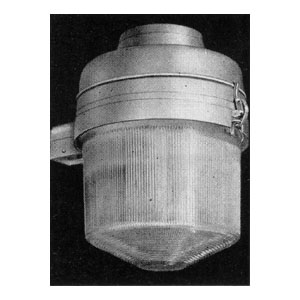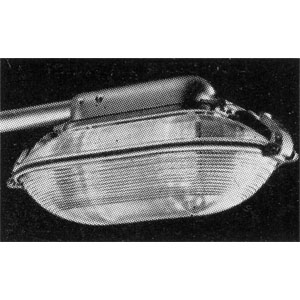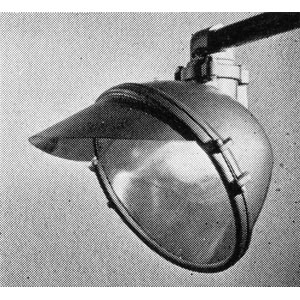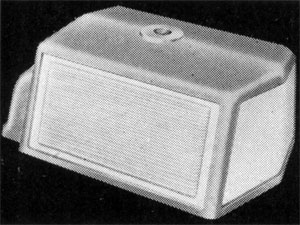ELECTRIC LIGHTING
GENERAL ELECTRIC CO., LTD., LONDON, W.C.2
Features common to nearly all G.E.C. street lighting lanterns are: (a) the lantern bodies are die-cast; (b) all die-castings
are of a light alloy chosen for its rigidity and high resistance to weathering and corrosion; (c) prismatic glasses for
the most part are made from heat-resisting glass and have smooth exteriors so that maintenance is facilitated; (d)
curved prisms used in teh refractors are covered by GEC patents.
|
|
THE DIFRACTOR LANTERN is extensively used for nearly every kind of main road lighting, and will take either 250 or 400-watt Osira
H.P.M.V. lamps. It employs a one-piece refractor bowl with internal curved prisms to provide the necessary redirection and diffusion of
light. It has a spun top which is removable to give access to the focusing arrangements, and the bowl is hinged so that
lamp replacement is easy. Site mounting suspension gives rigidity and provides easy fixing. This lantern can be converted with
300 or 500-watt Osram filament lamps by the simple addition of an inner symmetric dome refractor. |
 |
|
THE DIOPTRION LANTERN gives a controlled cut-off form of distribution and is for
use on broad roads where wide distribution is necessary. It is designed for use with horizontally-buring
250 or 400-watt Osira H.P.M.V. lamps. The design of the optical system is such that a rapid reduction
in candles above the peak reduces at high angles the amount of light which might otherwse produce
glare. Arranged for side-entry mounting, the body houses a series burning magnetic
deflector for controlling the arc discharge and carries two large dish-shaped refractors with
internal curved surface prisms.
|
 |
|
THE UNIWAY LANTERN gives uni-directional lighting and is designed for one-way streets or dual carriageways. Using either 80 or
125-watt Osira H.P.M.V. lamps it gives lighting results comparable with those obtained with 250 or 400-watt lamps in normal lanterns.
This optical system is a one-piece silvered glass reflector of special design. A hinged door carries the front diffusing glass.
|
 |
|
THE FACETED REFLECTOR LANTERN produces a directional type of lighting and is mainly for use on Class B roads. It will accommodate
Osram fialment lamps between 60 and 200 watts, or 80 and 125-watt Osira H.P.M.V. lamps. There are six mirror facets in each of the two wings.
The facets are removable and interchangeable so that replacement can easily be effected. The lantern compiles with the M.O.T. requirements
relating to glare ratio. Side-entry suspension at 30° from the vertical ensures that no condensation can enter the lantern from
the bracket.
|
|
|
THE SMALL OXFORD LANTERN is of the totally-enclosed type and can be used with either Osram filament, or Osira discharge lamps
of small denomination. The body is of spun copper, with a reinforced top. Variable focuing is provided and the light distribution
is controlled by a small bowl refractor in combination with an inner symmetric dome refractor.
|
|
|
THE SODIUM LANTERN FOR SIDE STREETS employs either 45 or 60-watt Osira sodium lamps. On each side, sealed prism refractor plates
control the light distribution up and down the road and an opal panel, facing across the road, allows light to fall on the opposite
pavement. The lampholder and lamp steady are carried on an over reflector which hinges downward to facilitate wiring.
|

|
|
THE REFRACTOR PLATE LANTERN FOR SODIUM LAMPS is designed for main road lighting and can be used with 85 or 140-watt Osira lamps.
Prismatic plates of the sealed sandwich type control the distribution of light. Top-entry suspension is provided.
|
|



